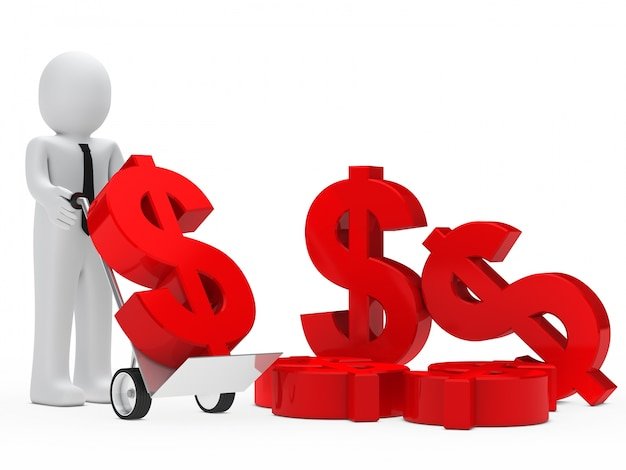How to determine the price of a product: 5 simple steps for your business
-
Roman Howler
Copywriter Elbuz
Have you ever tried to set a price for an item and didn't know where to start? This process seems mystically complicated, but don't worry... Look around: what are the prices of similar products from your competitors? For example, you have an online electronics store. You see that smartphones in the same class cost between 200 and 250 euros. Look at the product through the eyes of the customer. Why will he buy from you? Now imagine that you are selling unique design encyclopedias. Customers will value the original much higher than the standard edition. Do you know how much your product really costs? Do the math exactly: production, delivery, packaging. For example, if you sell handmade items, consider the cost of materials and your time. What if your smartphone costs 249.99 euros instead of 250? This is a small thing, but on a subconscious level the client feels the benefit. Even small tricks can significantly increase sales. Don't be afraid to experiment. Set different prices and monitor the results. When you buy training shoes, you may find that the €30 option wears better than the €35 one. Now that you have a plan for how to price an item, put these steps into practice and watch your business flourish.

Glossary
- 🌟 Competitors: Companies offering similar products or services in the same market, as is your company.
- 📊 Market Analysis: The process of studying the market to understand supply and demand and determine pricing strategy.
- 💰 Pricing: The process of setting prices for goods and services, including estimating costs, analyzing competitors, and considering market factors.
- 🛠️ Pricing Methods: Approaches to pricing such as cost-based method, competitive pricing and strategic pricing.
- 📈 Cost Pricing: A method of setting price based on the cost of producing a good or service plus the desired profit.
- 🏷️ Profitability: The degree of profitability of a product or service, calculated as the difference between income and costs.
- 📉 Competitive Pricing: A pricing method that is based on competitors' prices for similar goods or services.
- 🔧 Added value: Ways to improve a product or service to make it more attractive to consumers, for example through improved quality or adding new features.
- 🏗️ Algorithm: A clearly defined sequence of steps to complete a task, in this case setting the price of a product or service.
- 🆙 Price increase: The process of changing the price of a product or service to a higher price than the original price.
- 📨 Customer Communication: How do you inform your customers about all price changes and what do you do to maintain their loyalty .
- 🏁 Conclusion: The final part of the article, which summarizes the material considered, summarizes the key points and draws conclusions.
Pricing problems
Determining the right price for a product is a complex and multi-step process. Inspired by my personal pricing experiences, I'm sharing with you the steps that have helped me successfully set pricing strategies for different products.

Business Survival
In conditions of fierce competition and unclear demand, the main task of a business is survival. I have repeatedly encountered a situation where I had to work “to zero” just to cover costs and maintain the market.
📌 Example: I was launching a new product line in the children's toy market. Due to the enormous competition and saturation of the market, the starting price was set so low that we barely covered the production costs. However, this strategy allowed us to develop a client base and strengthen our reputation.
Increasing profits
When a business has already gained a foothold in the market, the time comes to review the pricing policy and increase profits. It is important to closely monitor changes in demand and offer the product at a price that is most profitable with optimal sales volumes.
📌 History: At one point for the children's line, we noticed that demand had stabilized. I was convinced that it was possible to increase the cost by 10% without losing client interest. This led to significant profit growth while maintaining customer loyalty.
Sales Growth
If your goal is to increase sales, changing your price can be a powerful tool to stimulate demand. It's important to find a balance that attracts new customers without reducing your profits.

📌 Recommendation: In my experience, this strategy worked when I reduced the price by 5% as part of a limited time offer. This allowed us to increase sales by 20% per month, attracting new customers and increasing brand awareness.
Fighting competitors
Reducing prices, offering discounts and bonuses are all effective methods of competing. I took part in promotions where we offered customers additional benefits: gifts with purchase or bonus coupons for their next purchase.
📌 Story: Once on the eve of New Year's sales, we offered customers discounts of up to 20% on the entire range and free shipping . This helped to significantly increase sales and lure away part of the competitors' customer base.
Create excitement
A high price for a new product often creates a sense of exclusivity and fuels interest. I used this strategy to promote a premium line, which created a significant response among consumers.
📌 Example: When introducing a new series of products to the market, I set high prices for them, focusing on their exclusivity . This not only increased interest, but also made it possible to attract a more solvent audience.

Review of useful practices:
| What's important to do | What to avoid |
|---|---|
| Analyze the market | Ignore competitors |
| Experiment with promotions and discounts | Neglect costs |
| Listen to customers | Ignore their opinions |
By following these steps and strategies, I am confident that you will be able to determine the price effectively for your product, maximizing profits and satisfying customer needs.
Main pricing factors
When I determined the price for one of my products, I realized that it is influenced by many factors. These factors can be divided into two large groups: internal and external. Internal factors are those that I can influence, while external factors are beyond my control. Let me share my findings and practical tips.

Internal factors
Cost of Production
Cost of Production is one of the main factors I considered when setting the price. When I was working on launching a new clothing line, I first calculated all the costs, from materials and labor to transportation costs and space rental.
☑️ Benefits:
- Accurate costing helps avoid losses.
- Takes into account real production costs.
☒️ Disadvantages:
- Does not take into account competition and market trends.
Marketing and Advertising
I also emphasized marketing costs. Given that one of my advertising campaigns became unexpectedly expensive, I adjusted the final price of the product to recoup the entire investment.
- 🔥 Tip: Consider product promotion costs such as online advertising, PR campaigns and bonuses for consumers.
External Factors
Market competition
One of the most difficult aspects was studying competitors. Analyzing their pricing strategies gave me the opportunity to determine the “sweet spot” for my product.

I remember analyzing the prices of competitors' men's suits to set my own price below the market average, but with sufficient margin to make a profit.
☑️ Benefits:
- Allows you to remain relatively competitive.
- Helps you understand the price range in your segment.
☒️ Disadvantages:
- Changes quickly and requires constant monitoring.
Purchasing power
I am confident that without taking into account the purchasing power of my customers, I could lose significant market share. When the economic crisis affected purchasing power, I had to reduce prices to retain existing customers and attract new ones.
- 📈 Tip: Monitor the economic situation and adapt your prices according to your financial capabilities target audience.
Seasonal variations and trends
Finally, another important factor that I always took into account These are seasonal trends. Of course, I sold winter clothes taking into account the time of year. The summer collection was more expensive during the peak season, while winter clothes were sold at deep discounts in the summer.

- ☀️ Tip: Follow seasonal trends and adjust the price of the product depending on the time of year.
Summing up
Here's a final list of best practices:
| Factors | Useful actions | Undesirable actions |
|---|---|---|
| Cost | Consider all costs. | Ignore cost components. |
| Marketing and Advertising | Tailor your price to your marketing expenses. | Ignore changing advertising budgets. |
| Market competition | Analyze and monitor competitors' prices. | Ignore the actions of competitors. |
| Purchasing power | Consider the economic status of the target audience. | Sell goods without taking into account purchasing power. |
| Seasonal variations and trends | Adjust price according with seasons and trends. | Ignore seasonal changes. |
These were the best practices that I used in my projects and I am confident that they will help you set a fair and competitive price for your item.
Price formation methods
In the process of determining the price of a product I have always relied on a few time-tested methods. This step-by-step methodology helped me set competitive and profitable prices for various products and services. Let's look at it in more detail.

🌟 Total cost method
The first step I always use is the total cost method. I consider it the basis for pricing because it can minimize the risk of loss and ensure a basic profit.
Your task:
- Determine the variable costs of production, such as raw materials and labor costs labor.
- Calculate fixed costs: for example, premises rental and administrative expenses.
- Add the planned profit to these costs.
💡 Example: If the production of a T-shirt costs 5 euros (materials, labor) and total fixed costs are 1 euro per unit of production, then by adding a 20% profit the price will be: 5 + 1 + (5 * 0.2) = 7 euros.
🔄 Direct cost method
This method is focused on changes in demand and has taught me in many projects when it was necessary to determine the optimal price for maximum sales.
🛠️ Process:
- Determine your variable and fixed costs.
- Set product margins based on demand and market conditions.
- Calculate the potential sales volume at different prices.
💰 Case study: When I was selling accessories for smartphones, I calculated , that the cost of producing the cover was 1.5 euros, and demand was purely dependent on the price, set a minimum margin of 0.5 euros → so the price was 2 euros.

📈 Marginal cost method
I used this method to introduce new products to the market when the main costs have already been covered.
🧮 Steps:
- Determine current fixed costs.
- Calculate the marginal cost of producing an additional unit of output.
- Determine the price based on profitability.
💡 Example: In launching a new food line, the marginal cost was 3 euros per unit . With an additional 30% markup, the final price was: 3 * 1.3 = 3.9 euros.
📊 Break-even point analysis method
I consider this method necessary for calculating the minimum break-even point and operational control of profitability. I explained it in detail in one of my previous projects, where it was critically important to avoid losses.
🔑 Stages:
- Determine fixed and variable costs.
- Calculate the break-even point: ({Fixed costs} / {Price} - {Variable costs} ).
- Set the price based on the required sales volume to cover costs.
📊 Real Life Example: In your jewelry project, fixed costs amounted to 10,000 euros. Variable costs - 5 euros per unit of production. By setting the price at 12 euros, I determined that the break-even point would be at 1,250 units sold.
🏦 Return on Investment (ROI) Method
When it comes to attracting investments, I personally always use the real return method .

📂 Implementation steps:
- Determine the total investment and fixed costs.
- Select the planned income ratio.
- Calculate the volume of production based on current costs and profit received.
💬 Example of my experience: For an online educational project, the total investment of investors was 100,000 Euro. By setting a return ratio of 30%, the price of the course package was set at 270 euros, which made it possible to return the investment and provide additional profit.
🛠️ Overview of methods
| Method | What's useful | What not to do |
|---|---|---|
| Total cost method | + Good for saving stable profit | - Ignore market changes |
| Direct method costs | + Sensitivity to changes in demand | - Set prices without market analysis |
| Marginal cost method | + Effective when releasing new products | - Set the price too low |
| Break-even point method | + Analysis of the minimum payback point | - Rely only on static data |
| ROI method | + Planning for return on investment | - Forgetting to take into account market risks |
I am convinced that the correct application of these pricing methods not only helps to set a fair and competitive price, but also significantly increase business profitability.
Competitor analysis as a basis for setting the price of a product
Why is competitor research necessary?
When I first faced the task of pricing a new product, I realized that the most important step was to thoroughly analyze the competition. I can say with confidence that without this step it is impossible to set a competitive price. Your competitors have already done much of the work: researching demand, assessing the value of the product, and testing different pricing strategies.

How did I conduct competitor analysis?
I suggest you start by making a list of the top competitors in your niche. For this I used:
- 🔍 Search engines: Google, Bing.
- 🛒 Online platforms: Marketplaces such as Amazon, eBay, Rozetka, prom.
- 💬 Social networks: Instagram, Facebook.
After analyzing their websites and trading platforms, I collected information about prices for similar products. I also recommend paying attention to:
- 📈 Price ranges: Minimum, average and maximum price.
- 💬 Customer reviews: Help to evaluate how well the price matches the quality and customer expectations.
The results of competitor analysis helped me determine the starting prices for our product and adjust them depending on the market situation.
A specific example from my practice
In one of my projects, I was launching a new sportswear brand. The competition was high, and I decided: first, I would study how pricing among market leaders dictates its own rules. After conducting a thorough competitor analysis, I found that most of the companies were offering discounts and promotions to attract customers.
I decided to use a similar strategy, but with a slight difference: we offered customers free shipping and gift wrapping. This small but noticeable advantage allowed us to stand out from our competitors and attract new customers.
Practical tips for conducting competitor analysis
- 🏆 Please note Focus on market leaders: They set trends and shape customer expectations.
- 💵 Study the pricing policies of different categories: Assess how prices vary depending on the quality and characteristics of the product.
- 📊 Use analytics tools: Services like SEMRush can help you gather competitive pricing data.
- 👥 Don't forget about small competitors: They can offer unique conditions and strategies that can be used as an example.

I I am convinced that a thorough competitor analysis is the best way to understand market realities and prepare for a successful market entry.
Review of best practices in competitor analysis
| Actions | What's useful | What not to do |
|---|---|---|
| Price comparison | Explore all price ranges | Distort results |
| Analyze reviews | Understand customer needs | Rely only on positive reviews |
| Using analytical tools | Get accurate data | Ignore free resources |
| Visit competitors' sites | Learn about offers and promotions | Copy their exact strategies |
Therefore, I recommend that you approach your competitor analysis with the utmost care, use all the tools available, and interpret the information carefully. Please note that experience and an innovative approach will definitely lead you to success.
Adding value: tools for success
When I started my journey in business, I realized that standing out from competitors is an important component of success. This got me thinking about additional tools that could add value to my product. Here are some methods that I have personally tried and approved:
🛍️ Eco-friendly and attractive packaging
In one of my first projects I decided to use beautiful, tactile and eco-friendly packaging for my product. I noticed that clients appreciate care for nature and attention to detail. For example, I included small cards with thanks for the purchase and brief instructions on how to use the product. Customers were happy to report that such packaging brought them pleasant emotions and a desire to return for new purchases.

☑️ High-quality and friendly service
One day I decided to strengthen our service and looked at it from a different perspective. The main focus was a friendly attitude and willingness to help at all stages of interaction with the client. My employees received special training, which allowed them to easily and effectively interact with customers. The result was not long in coming: the number of regular customers increased by 30%, and the feedback was extremely positive. I am convinced that people are willing to overpay for quality service.
🎁 Loyalty and reward programs
I recommend that you consider implementing a loyalty system. In one of my projects, I introduced bonus programs and cumulative discounts. This was a great move as it made customers feel valued and important. For example, every fifth order was accompanied by a small gift, which encouraged customers to come back again and again. I am convinced that such a system sets you apart from your competitors.

🚀 Influence of social media and reviews
I also actively use my social media presence to add value to the product. I constantly keep in touch with my audience, sharing stories, reviews and educational content. In one of my projects, clients actively participated in competitions and sweepstakes, which increased their loyalty and interest in the brand.
📊 Financial analysis and cost optimization
Finally, I recommend that you pay attention to the financial aspects. I always carefully analyze the costs of production and delivery of goods in order to offer clients a competitive price without compromising on quality. Analyzing competitors and setting an adequate price is an important part of the strategy that I put into practice.
I believe that proper attention to detail makes your product unique and attractive to customers. Care, attention and sincerity always return a hundredfold.

Tool overview table
| Tool | Benefits | Disadvantages |
|---|---|---|
| Eco-friendly packaging | Pleasant emotions, environmental friendliness | More costs |
| Quality service | Customer loyalty, distance reduction | Requires staff training |
| Loyalty system | Increase in repeat purchases | Costs of bonuses and gifts |
| Social media | Strengthening brand presence, feedback | Time for content management |
| Financial analysis | Cost optimization, competitiveness | Requires careful analysis |
These techniques have helped me significantly increase the value of my products and strengthen my relationships with my customers. I hope my tips and examples will help you achieve business success.
How to inform customers about a price increase
One of The most difficult aspect of running a business is having to communicate price increases to customers. As someone with significant experience in this area, I can confidently say that the key to a successful transition to higher prices lies in honesty and openness. In this chapter, I'll share how I successfully informed my clients about upcoming pricing changes and offer practical tips to help you do the same.

📧 Story about the price increase in advance
When faced with the need to raise prices, I always tried to warn clients in advance. I believe that this is an important aspect of business relationships, as it allows clients to prepare for changes. The most effective tool in this case for me was the newsletter. The more time clients have to adapt to new conditions, the better they accept change.
📢 Explanation of the reasons for the price increase
It has always been obvious to me that clients value sincerity and openness. When I explained to my clients the reasons for the increase in cost, it always caused them to understand and even be loyal to my company. For example, I once had to increase the price of water coolers due to a significant increase in the cost of raw materials. I discussed this in detail with clients, and most of them accepted this decision with understanding.
🏷️ Offering remaining goods at the old price
In some cases, in order to mitigate the result of price increases, I offered remaining goods at warehouse at the old price. This not only strengthened my reputation, but also created additional demand among clients. Imagine how customers willingly ordered the remaining goods, knowing that the price would soon change.
📅 An example from my experience
I want to share a specific example. Several years ago, my company needed to increase the price of technical maintenance services due to rising costs. We started sending out email notifications a month in advance of the upcoming change. Each letter explained in detail the reasons for the increase, provided graphs and tables with data on the increase in costs. In addition, we have offered previous services at the old prices to all current customers within a week of notification.

Useful and unhelpful practices
Remember that customers value transparency and honesty. This increases their trust and increases the likelihood of maintaining a long-term business relationship.
| Helpful | Not helpful |
|---|---|
| 🟢 Warn in advance | 🛑 Ignore the problem |
| 🟢 Explain reasons | 🛑 Short notice |
| 🟢 Offer old prices | 🛑 Conceal important details |
| 🟢 Display containers | 🛑 Ignore customer opinions |
I can say with confidence that an approach based on transparency and dialogue with clients has always brought positive results. I strongly encourage you to pay attention to these strategies and implement them in your practice.
Conclusion: Cost accounting and competitor research
On From my own experience, I can say that a successful pricing policy always begins with a deep analysis of competitors and taking into account all types of costs. In one of my previous projects, we were able to significantly increase the company’s profitability precisely thanks to the correct approach to pricing.

Cost Accounting
When I was pricing a new product, my first priority was to accurately determine all the costs. It is worth remembering that this includes not only direct production costs, but also overhead costs: renting premises, marketing, employee salaries and other age-related facts. For example, on a recent project I encountered a situation where hardware maintenance fees were overlooked, which could have impacted the final cost of the product.
Competitor Analysis
I always advise you to carefully study your competitors' offers. To do this, you can use various online services, as well as conduct direct monitoring of their stores and websites. One client I worked with took their business to the next level because we analyzed the pricing of its main competition and identified missing services and benefits that could make its offering more attractive.
Balancing the interests of business and customers
After analyzing and taking into account all the factors, it is important to balance the interests of the business and its target audience. In my practice, I have found that sometimes it is worth sacrificing profit in order to attract more clients. For example, I once offered my client a promotion with a large discount coupon, which attracted new customers and ultimately increased overall profit due to sales volume.

Importance of a real-life example
Let's look at a real example. I worked with an electronics store that initially set prices without proper market analysis. After reviewing our pricing policy and taking into account all costs, we reduced the price of a popular product by 10%, which led to an increase in sales by 30%. Using this approach, the business has achieved a successful balance between cost and supply.
Main difficulties and useful tips
🚀 Best practices:
- 📊 Competitor analysis is required
- 💰 Accounting for all types of costs
- 🛠️ Regular price revision
- 👥 Taking into account the needs of the target audience
❌ What to avoid:
- ❌ Underestimating costs
- ❌ Misunderstanding the audience
- ❌ Ignoring seasonal changes and competitors' promotions
Thus, taking into account costs, analyzing competitors and adapting to the market, you can create a successful pricing policy. I am confident that these steps will help you make the right choice and strengthen the position of your business.

Experience Electrolux
Electrolux is one of the world leaders in the production of household appliances and professional equipment. The company offers products such as refrigerators, washing machines, vacuum cleaners, stoves and many more, striving to provide high quality and innovation in every product.

Project goals and objectives
Electrolux's main goal in this project is to establish the optimal price for new models of kitchen appliances that will be beneficial to consumers and competitive in the market. To do this you need:
- Conduct a competitor analysis 🏢
- Take into account production costs 💰
- Identify target audience 👨👩👧👦
- Develop pricing strategy 📈
Formulation of the main problem
Electrolux was faced with the task of choosing an effective pricing methodology for a new range of premium kitchen appliances. The company already has a strong position in the market, but new models require up-to-date price justification to increase attractiveness among users.
Description of the target audience
Electrolux's target audience includes:
- High-income families who value the quality and durability of household appliances.
- Professional chefs and restaurants need reliable equipment.
- Tech-savvy consumers 🧑💻 interested in the latest developments and functional features.

Key points that attract customers' attention
- High quality products: Electrolux cares about every detail, from design to assembly.
- Innovative technologies: Each new model uses the latest scientific advances.
- Eco-friendly: Use of energy-efficient technologies and eco-friendly materials.
- Versatility and ease of use: Electrolux products are highly functional and easy to use.
Analysis results table
| Stage | Actions | Results |
|---|---|---|
| Competitor analysis | Price comparison and characteristics with competitors | The main advantages and disadvantages in comparison with direct competitors |
| Cost accounting | Estimation of production costs and logistics | Process optimization, which reduced costs by 10 % |
| Determining the target audience | Marketing research | New market segmentation and target audience defined |
Real example of success
"After implementing the new pricing strategy, we saw a 25 increase in sales of the premium range % during the first six months." , comments the head of marketing at Electrolux, Thomas Jensen.
Thus, the project allowed Electrolux not only improve understanding of your target audience, but also set competitive prices that attract new customers and promote sales growth.
Frequently asked questions on the topic: How to determine the price of a product - 5 simple steps for your business
1. What are the basic steps to determine the price of a product?
2. How to conduct a competitor analysis to set a price?
3. What costs should be taken into account when pricing?
4. How to determine the optimal price range?
5. How to test the price?
6. Why is it important to monitor market changes?
7. What problems are solved using pricing?
8. What factors influence pricing?
9. How to create additional value for a product or service?
10. How to inform customers about a price increase?
Thank you thank you for reading and for becoming more prepared 🤓
Now you are not just a reader, you are a real professional in determining the price of a product. Remember how you carefully analyzed competitors, calculated costs and set the final price. Every step was like a small journey into the world of online trading. Feel free to apply this knowledge and watch your business flourish! I look forward to your comments and success stories, it's always so inspiring! 🚀
Roman Revun, independent expert "Elbuz"

- Glossary
- Pricing problems
- Main pricing factors
- Price formation methods
- Competitor analysis as a basis for setting the price of a product
- Adding value: tools for success
- How to inform customers about a price increase
- Conclusion: Cost accounting and competitor research
- Experience Electrolux
- Frequently asked questions on the topic: How to determine the price of a product - 5 simple steps for your business
- Thank you thank you for reading and for becoming more prepared
Article Target
Teach readers the basic methods of setting the price of a product and offer practical tips for their application.
Target audience
Small and medium-sized entrepreneurs, marketers, sales managers
Hashtags
Save a link to this article
Roman Howler
Copywriter ElbuzMy path is the road to automating success in online trading. Here words are weavers of innovation, and texts are the magic of effective business. Welcome to my virtual world, where every idea is the key to online prosperity!
Discussion of the topic – How to determine the price of a product: 5 simple steps for your business
A detailed description of each of the steps to determine the price of a product, from competitor analysis to cost accounting. Real examples and practical advice.
Latest comments
15 comments
Write a comment
Your email address will not be published. Required fields are checked *

























John Smith
Roman Revun, very interesting. What criterion do you consider the most important in competitor analysis? 🤔
Anna Müller
John, I usually look at competitors' pricing strategies and their offerings. For example, in Germany, many companies first lower their prices to attract customers and then raise them. 🚀
Marie Dupont
Anna Müller, interesting approach, but how do you take costs into account? 🤓
Luca Rossi
Marie, to account for costs, I always do a detailed analysis of all components. For example, materials, handmade, delivery. It helps.
Karol Kowalski
It is also important to take into account the quality characteristics of the product. Otherwise, you can sell it at a higher price if you show that the product is better than its competitors.
Sergio Garcia
Carol, I agree! In Spain we often do this. They sell quality goods at a higher price, and it works. 💡
Nina Popova
I've always found it difficult to evaluate the cost compared to competitors. Sometimes it feels like we are underestimated. 🧐
Olga Ukrainka
Nina, I have the same problem on the Ukrainian market. What steps do you take to accurately determine your price?
Роман Ревун
John Smith, in my opinion, the most important criterion is understanding the target audience of competitors and their value. Anna Müller, great example! To account for costs, Marie Dupont, it is best to make a full calculation and recalculate every six months. Nina Popova, try to identify the unique advantages of your product. 🚀
Hans Schmidt
All your steps are a waste of time. It is better to focus on proven methods of the past. Trends and competitors still change. 🧐
Marie Dupont
Hans Schmidt, this is definitely not about our market. We must adapt to new conditions! 😉
Anna Müller
I try to analyze everything, I can’t do without it. Hans Schmidt, maybe you should try a new approach?
Sergio Garcia
I recently had a case when a competitor lowered the price, and on the contrary, we raised it. It turned out that more clients came to us. 😅
John Smith
Interesting, Sergio! Maybe they took it as an indicator of quality.
Olga Ukrainka
Roman Revun, thanks for the advice! I will take into account the cost calculation every six months.